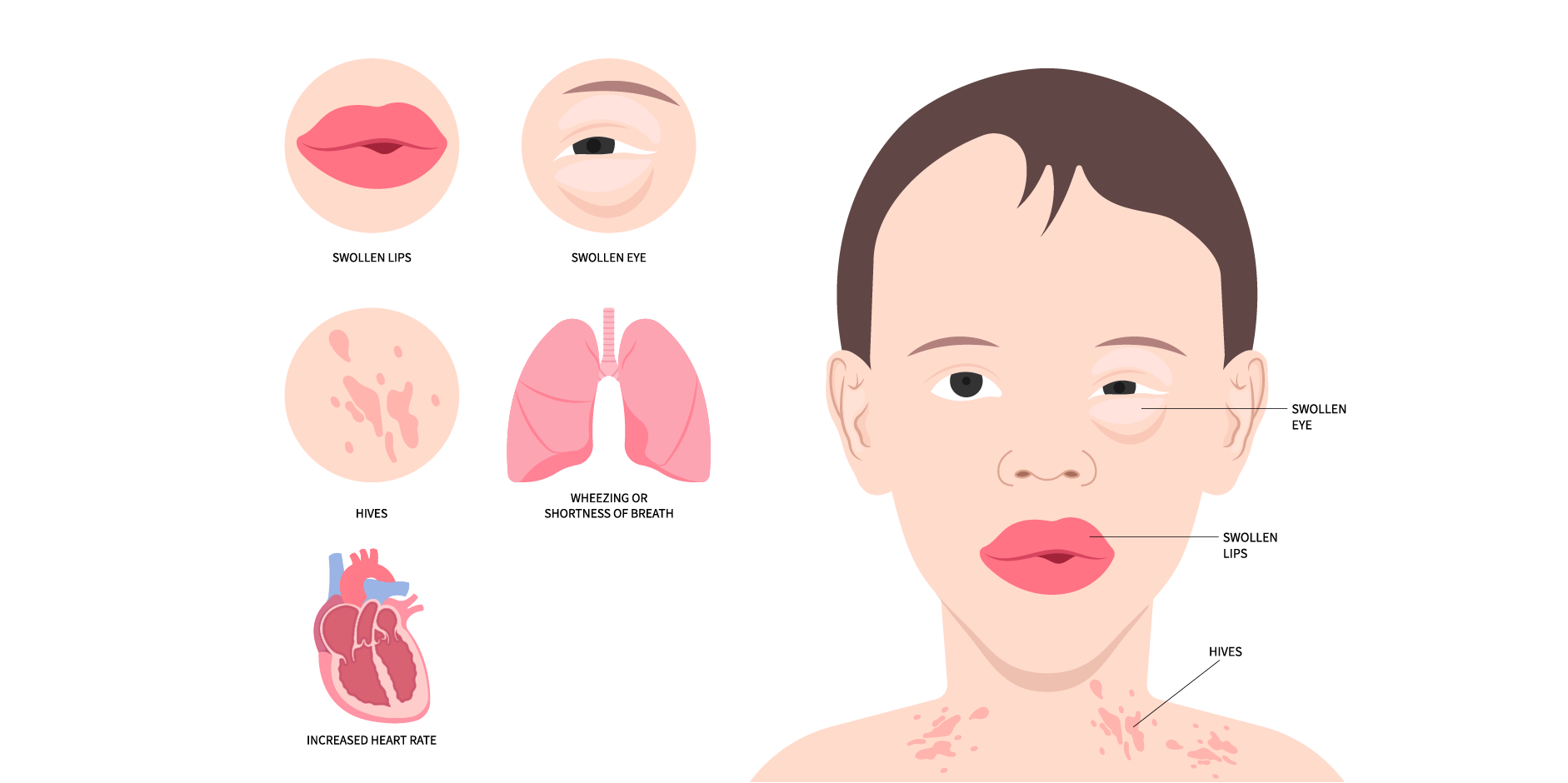Content on this page:
Content on this page:
Clinical Presentation
Signs and Symptoms
The patient’s age is not correlated with reaction severity and initial
reaction to an allergen leading to anaphylaxis is unlikely when it comes to
infants and toddlers. Age-specific symptoms are less often seen in older
children and adults may be seen in infants and toddlers. Allergic reactions, such as crying and fussiness, may
overlap with normal behavior in infants and children. It must be noted
that the longer the symptoms develop, the less severe the overall reaction.
Grading the severity of clinical symptoms as 1 to 5 based on the organ system
affected may be helpful in the diagnosis and timely administration of
Epinephrine.
Cutaneous
The most common manifestation of anaphylaxis is cutaneous, occurring in
more than 90% of cases. However, it must be noted that cutaneous manifestations
may be delayed or absent in rapidly progressive anaphylactic reaction.
Cutaneous manifestations include urticaria, angioedema (including periorbital
edema, conjunctival swelling), flushing, pruritus (may begin on the palms
and soles), and mottling in infants.
Respiratory
Respiratory manifestations of anaphylaxis occur in up to 85% of
episodes. Respiratory manifestations include rhinorrhea, nasal congestion,
throat tightness, hoarseness, sudden or ‘barky’ cough, stridor, wheeze,
dyspnea, and chest tightness.
Gastrointestinal
Gastrointestinal manifestations of anaphylaxis occur in up to 45% of
episodes. These include oral pruritus, nausea, vomiting,
spitting up in infants, hiccups, repetitive lip licking in infants,
dysphagia, diarrhea, and crampy abdominal pain.
Cardiovascular
Cardiovascular manifestations of anaphylaxis occur in up to 45% of
episodes. These include dizziness, tachycardia, persistent
unexplained tachycardia in infants, chest pain, hypotension, cyanosis, and
collapse.
Neurological
Neurological manifestations of anaphylaxis include restlessness, persistent and unexplained irritability, inconsolability,
crying, withdrawal behavior, dizziness, lightheadedness, sense of
impending doom, confusion, loss of consciousness, headache, seizure, hypotonia, and decreased activity.
 Anaphylaxis (Pediatric)_Initial Assesment
Anaphylaxis (Pediatric)_Initial AssesmentHistory
History taking is a key part of the diagnostic work-up. It is important to identify risk and predisposing factors for possible recurrence (eg history of previous anaphylactic reactions, history of atopy, asthma even if well-controlled, adolescence, family history of any type of allergic reaction). Family history remains the most practical and useful tool in identifying allergy-prone infants. The presence of allergic diseases in one or both parents and in a sibling increases the likelihood of allergy in a child. The time of the onset of symptoms and the circumstances prior to the reaction are determined and recorded, including the treatments given. A detailed history of all the food and drugs taken, and all the patient’s activities, including history of sting or bite is obtained within a 2-hour period of the episode.
Diagnosis or Diagnostic Criteria
There is no gold standard diagnostic exam
for anaphylaxis. Its diagnosis relies on clinical assessment.
Clinical Criteria for the Diagnosis of Anaphylaxis
Diagnosis of anaphylaxis is highly likely when any one of the following
is fulfilled:
- Acute onset of illness minutes to several hours' duration involving the skin, mucosal tissue, or both (eg pruritus, flushing, generalized hives, edema of the lips, tongue and uvula)
- Plus
at least one of the following:
- Respiratory compromise (eg dyspnea, stridor, bronchospasms, wheezing, hypoxia, decreased peak expiratory flow [PEF])
- Reduced blood pressure (BP) or end-organ dysfunction symptoms (eg collapse, syncope, incontinence)
- Severe gastrointestinal symptoms (eg severe crampy abdominal pain, repetitive vomiting), especially after exposure to non-food allergens
Diagnosis of anaphylaxis can also be made with acute onset of hypotension, bronchospasm or laryngeal involvement after exposure within minutes to several hours to a known or highly probable allergen particular to the patient, even in the absence of typical skin involvement. This does include lower respiratory symptoms triggered by common inhalant allergens or food allergens perceived to cause “inhalational” reaction in the absence of ingestion.
- Hypotension is defined as:
- Systolic BP (SBP) <60 mmHg for term neonates (0 to 28 days)
- SBP <70 mmHg for 1 month to 1 year of age
- SBP <(70 mmHg + [2 x age]) for 1 to 10 years of age
- SBP <90 mmHg for 11 to 17 years of age
- >30% decrease in SBP for all ages
